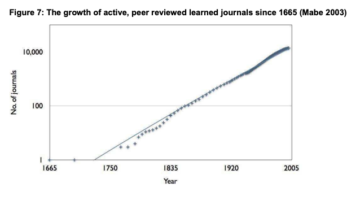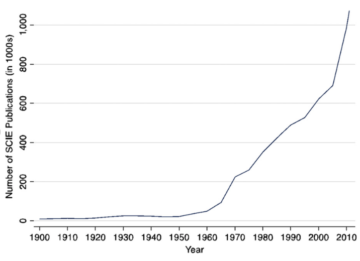by Joseph Shieber

In a recent talk at the Santa Fe Institute, the software engineer and tech startup founder Jason Crawford, who has in the last few years devoted his time to the Roots of Progress nonprofit, offered suggestions for developing institutions capable of fostering the acceleration of scientific progress.
Crawford framed the discussion around three questions: “When (if ever) has science accelerated in the past? Is it still accelerating now? And what can we learn from that?”
On the first question, whether science has accelerated in the past, Crawford offers an unequivocal “yes,” noting, in a whirlwind history, that
In the ancient and medieval world, we had only a handful of sciences: astronomy, geometry, some number theory, some optics, some anatomy
In the centuries after the Scientific Revolution (roughly 1500s–1700s), we got the heliocentric theory, the laws of motion, the theory of gravitation, the beginnings of chemistry, the discovery of the cell, better theories of optics
In the 1800s, things really got going, and we got electromagnetism, the atomic theory, the theory of evolution, the germ theory
In the 1900s things continued strong, with nuclear physics, quantum physics, relativity, molecular biology, and genetics
Though Crawford’s survey of the historical trends is brief, he is undoubtedly correct (and has much more to say about the historical record of progress on the blog for his nonprofit, The Roots of Progress). Just to underscore the point, it would be worth it to look at a few measures highlighting the acceleration of science.
For example, the number of active, peer reviewed learned journals has exploded since the 1700s (from the 2018 STM Report):

Correspondingly, the number of scientific articles has also ballooned. Indeed, just since the 1970s, the number of scientific articles has risen from a few hundred thousand to over 3 million, by some measures (also from the 2018 STM Report):

Taking a longer view, since 1900, we can see that scientific publications skyrocketed from a few thousand in 1900 to over one million in 2010 (from Powell et al., “Introduction: The Worldwide Triumph of the Research University and Globalizing Science: The Global Triumph of the Research University”):

Crawford claims that he is not terribly interested in his second question, “Is [science] still accelerating now?”: “I’m leaving aside the question of whether science has slowed down since ~1950 or so, which I don’t have a strong opinion on. Even if it has, that’s mostly a minor, recent blip in the overall pattern of acceleration across the broad sweep of history. (Or, you know, the beginning of a historically unprecedented reversal and decline. One or the other.)”
Crawford lists a number of factors driving acceleration in science: funding, people, instruments, computation, communication, methods, institutions, and social status. Crawford suggests that on all of these measures – with one notable exception – science is thriving. Social status for scientists, Crawford suggests, is high. Funding is at high levels (particularly when compared to the patronage system of the 1700s and early 1800s). There are more researchers working in science than ever before in all of human history. Our scientific instruments are vastly superior to those employed by, say, Tycho Brahe or Robert Koch. Furthermore, the computers of the 2000s are infinitely more powerful than the roomful of human computers employed by Edward Charles Pickering (and, later, Annie Jump Cannon) at the Harvard College Observatory around 1900.

Credit: Courtesy of the Harvard University Archives.
The one factor that Crawford finds lacking has to do with the institutions of science. Crawford lists a number of criticisms having to do with those institutions:
Speed. It can easily take 12–18 months to get a grant (if you’re lucky)
Overhead. Researchers typically spend 30–50% of their time on grants
Patience. Researchers feel they need to show results regularly and can’t pursue a path that might take many years to get to an outcome
Risk tolerance. Grant funding favors conservative, incremental proposals rather than bold, “high-risk, high-reward” programs (despite efforts to the contrary)
Consensus. A field can converge on a hypothesis and prune alternate branches of study too quickly
Researcher age. The trend over time is for grant money to go to older, more established researchers
Freedom. Scientists lack the freedom to direct their research fully autonomously; grant funding has too many strings attached
Crawford contrasts scientific institutions negatively with those of venture capital (VC), writing
as a former tech founder, I can’t help but notice that most of these problems seem much alleviated in the world of for-profit VC funding. Raising VC money is relatively quick (typically a round comes together in a few months rather than a year or more). As a founder/CEO, I spent about 10–15% of my time fundraising, not 30–50%. VCs make bold bets, actively seek contrarian positions, and back young upstarts. They mostly give founders autonomy, perhaps taking a board seat for governance, and only firing the CEO for very bad performance. (The only concern listed above that startup founders might also complain about is patience: if your money runs out, you’d better have progress to show for it, or you’re going to have a bad time raising the next round.)
I don’t think the VC world does better on these points because VCs are smarter, wiser, or better people than science funders—they’re not. Rather, VCs:
Compete for deals (and really don’t want to miss good deals)
Succeed or fail in the long run based on the performance of their portfolio
See those outcomes within a matter of ~5–10 years
In short, VCs are subject to evolutionary pressure. They can’t get stuck in obviously bad equilibria because if they do they will get out-competed and lose market power.
I am skeptical of Crawford’s diagnosis. In the age of Elon Musk, Peter Thiel, and SBF, I don’t think the mantra, let’s all have institutions that behave more like VCs is worth taking all that seriously.
There’s also a slippage in Crawford’s understanding of “the institutions of science.” Is he thinking here of universities, granting agencies, peer reviewed journals, professional societies? Each of those institutions have different structures. Many of Crawford’s criticisms – and his few actual proposals – seem to address problems with granting agencies, although his one contemporary example – Katalin Karikó – involved a failure of a university to recognize research potential with tenure.
There’s also a strange inconsistency in dealing with the historical evidence. In the case of funding, for example, Crawford declares scientific funding to be healthy because “Once, scientists had to seek patronage, or be independently wealthy. Now there is grant money available, and the total amount of funding has increased significantly in the last several decades.” If one used a similar method of analysis, it would be difficult to argue that the institutions of science were healthier in the 17th or 18th centuries than they are today.
The main problem with Crawford’s analysis, however, is that he fails to understand the role of evolution in science.
As a matter of fact, as Philip Kitcher’s work in the Advancement of Science demonstrated, science is already – and has always been – subject to evolutionary pressures.
Kitcher sees the evolutionary processes of variation and selection operating on scientific approaches, methods, and theories. Scientists explore a variety of ideas, generate hypotheses, test and apply methods, and formulate theories. The approaches, methods, and theories that yield the most success – as measured by their accuracy, fruitfulness, coherence – eventually gain more widespread use. Other scientists gradually abandon less successful approaches in favor of the more successful ones.
Recent work by Joe Henrich and his collaborators buttresses Kitcher’s analysis of scientific progress. Henrich argues that human cultural capacities have always evolved through a Darwinian process of variation, selection, and inheritance of cultural traits. According to this work, it is cultural evolution that enables the accumulation of increasingly complex customs, skills, knowledge, and technology over generations.
What this suggests is that Crawford’s analysis is fundamentally misplaced. Evolution is already operative on science – at many different “levels of selection,” including institutional ones. Unfortunately, analyses like Crawford’s seem likely to do little to help accelerate scientific progress, but do much to serve the goal of VC to hollow out institutions – like traditional universities – seeking to serve the common good by focusing on the pursuit of truth rather than the maximization of profit.
